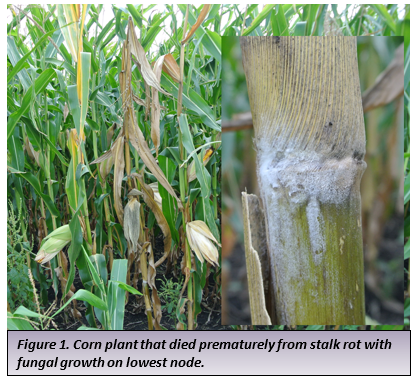Scouting for Corn Stalk Rot
This page was adapted from the article, "Corn Stalk Rot," which appeared in Crop & Pest Report on September 23, 2021.
Stalk rot can be a serious corn disease issue. Stalk rots, caused by several pathogens, can prematurely kill plants, shred the inner pith, and lead to lodging (Figure 1). Stalk rots are more problematic in fields that experienced significant stress (ie: moisture, disease, hail, etc), and the plants will cannibalize the nutrients in the stalk to promote cob fill. This allows opportunistic fungi (ie: Fusarium) to colonize the inside of the stalk. Sometimes fungal growth can be observed on the outside of infected plants near the nodes (Figure 1). Late September is a great time to scout for stalk strength in the corn crop. The best way to scout for stalk strength is using a pinch or push test. For each test, randomly select 100 plants in a field using a ‘W’ pattern, and if 10% of the plants fail the test, prioritize that field for an earlier harvest (if possible) to avoid potential lodging issues.
Pinch Test: Pinch the stalk at one of the lowest two internodes. If your thumb pressure causes the stalk to collapse, it fails the pinch test.
Push Test: Push the stalk to a 30-degree angle (8-10 inches), and if the stalk does not spring back to the original position, it fails the push test.

Andrew Friskop
Extension Plant Pathology, Cereal Crops
